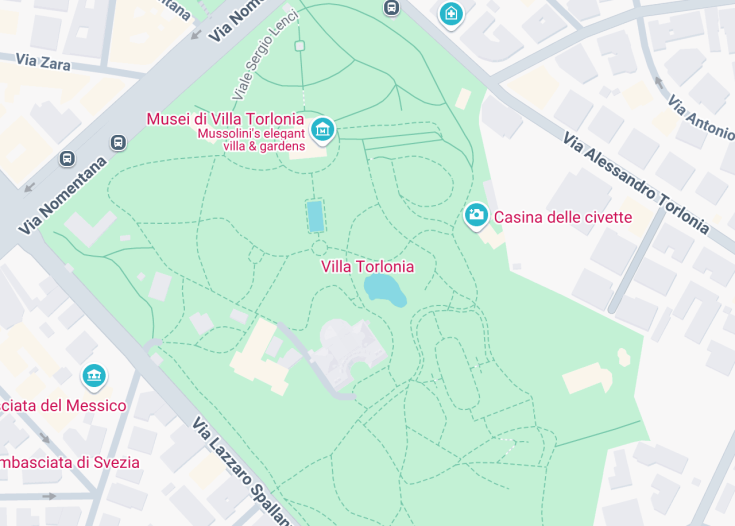Villa Torlonia, an exquisite park located in the heart of Rome, Italy, serves as a significant example of neoclassical architecture and landscape design. Once a private residence of the prominent Torlonia family, this historical site showcases elegant buildings and lush gardens, offering visitors a glimpse into the rich cultural heritage of the city. Since its opening to the public in 1978, Villa Torlonia has become a cherished urban oasis for both locals and tourists alike.
For an immersive experience, consider visiting Villa Torlonia during the weekdays when the crowds are lighter. This will provide you an opportunity to explore its tranquil gardens and captivating museums without the hustle and bustle.
Plan to allocate a few hours for your visit to this architectural gem. Ensure to check for any temporary exhibitions or events hosted at the villa during your stay to enhance your experience of Villa Torlonia.
Villa Torlonia in Rome, Italy
Villa Torlonia is a remarkable historical site located in the Nomentano district of Rome, renowned for its exquisite neoclassical architecture and substantial cultural heritage. This grandiose villa complex epitomizes the aesthetic of Italian villa design, featuring a meticulously landscaped park that sprawls across approximately 13 hectares. Central to the estate is the Casino Nobile, characterized by its stunning façade adorned with giant columns, intricate stucco work, and murals that reflect the classical influences prevalent during its construction. The villa showcases various architectural styles, including neoclassical and neo-Gothic elements, evident in structures like the Casino dei Principi and the whimsical Casina delle Civette, which features vibrant stained-glass windows and decorative motifs inspired by nature.
Important art collections within the museums housed in Villa Torlonia further accentuate its cultural significance, presenting visitors with a rich narrative of Rome’s artistic past. The villa’s extensive gardens are interspersed with artistic follies, such as the Faux Ruins and the Temple of Saturn, enhancing the picturesque scenery while serving as a testimony to the romantic landscape ideals of the 19th century. Notably, the complex has served historical figures, including Benito Mussolini, who resided in the Casino Nobile during his regime.
History
17th – 18th Century: Early Ownership
The origins of Villa Torlonia trace back to the 17th century when it was owned by the Pamphilj family, who utilized it primarily for agricultural purposes. In the mid-18th century, the Colonna family acquired the estate but continued its agricultural function, leaving the area largely undeveloped.
19th Century: Construction and Expansion
Significant transformation began in 1806, under the direction of architect Giuseppe Valadier, for Giovanni Raimondo Torlonia, who envisioned the villa as an opulent residence. Over the decades, further enhancements were made by his son Alessandro, leading to the construction of notable structures like the Casino dei Principi and the Casina delle Civette, reflecting evolving architectural trends.
20th Century: Mussolini’s Residency
In the 1920s, Villa Torlonia became the official residence of Benito Mussolini and his family, marking a controversial chapter in its history. The villa served as a backdrop to significant political events until the fall of Mussolini in 1943, after which it fell into disrepair and neglect.
1970s – Present: Restoration and Public Access
The villa’s revival began in 1978 when the City of Rome acquired it, launching restoration projects that aimed to restore its former glory. Currently, Villa Torlonia operates as a public park and cultural site, with several museums and exhibitions, making it accessible for both locals and tourists.
Attractions at Villa Torlonia in Rome
Visitors to Villa Torlonia can explore various attractions, including the Casino Nobile, displaying exquisite neoclassical interiors and notable artworks. The Casina delle Civette offers an enchanting experience with its fairy-tale architecture and delightful mosaics. Furthermore, the gardens feature ornamental ponds, quiet walking paths, and the scenic Faux Ruins, inviting leisurely strolls amidst historical beauty.
A grand architectural feature within Villa Torlonia in Rome
A standout feature of Villa Torlonia is the striking Casino dei Principi, a testament to the grandeur of 19th-century aesthetics. This building was designed as a reception hall and showcases beautifully preserved frescoes and intricate stuccoes that evoke the elegance of the period. Its architectural style reflects a blend of neoclassical and Renaissance influences, captivating visitors with its majestic presence.
General Informations
Location
Villa Torlonia is located in the Nomentano district of Rome, easily accessible to visitors. The park is near notable landmarks and transport hubs, including Viale Regina Margherita and the Policlinico metro station.
Address:
Via Nomentana, 273-263, 00198 Roma RM, ItalyVisiting Information
The park is open to the public every day from dawn until dusk, offering a peaceful environment to explore its historical buildings and lush greenery. For the best experience, consider visiting in the morning or late afternoon when the light is most flattering and the park is less crowded.
How to Reach Villa Torlonia
Car
Villa Torlonia can be easily reached by car, with parking available in surrounding areas for a nominal fee. It’s conveniently located off major routes.
| Route | Distance | Travel Time |
|---|---|---|
| From Rome city center | 3 miles (5Km) | 15 minutes |
| From Termini Station | 2 miles (3Km) | 10 minutes |
| From Fiumicino Airport | 20 miles (32Km) | 35 minutes |
Public Transport
For those using public transportation, Villa Torlonia is conveniently served by various bus lines and trams. The nearest stops are located along Via Nomentana.
| Transport Option | Travel Time from City Center |
|---|---|
| Tram (Line 3 or 19) | 15 minutes |
| Bus (Lines 60, 66, 62) | 20 minutes |
Accessibility and Limitations
Villa Torlonia is generally accessible to visitors, with paved paths and accessible entrances to many of the attractions within the park.
Accessibility
Limitations
- Some areas may be closed for maintenance or restoration work.
- Events or private bookings can restrict access to certain sections of the park.
Notes to visitors
- Plan your visit ahead of time to check for any temporary closures related to ongoing restorations.
- Be prepared for varying terrain throughout the park.
Common Questions
What are the main attractions in Villa Torlonia?
Villa Torlonia hosts several remarkable attractions that draw visitors due to their architectural beauty and historical significance.
-
Casino Nobile: This is the main villa at Villa Torlonia, showcasing Neoclassical architecture, complete with grand columns and beautiful frescoes.
-
Casino dei Principi: A splendid building used for receptions, known for its exquisite Renaissance Revival style and unique decorative features.
-
Casina delle Civette: This enchanting building is a blend of Art Nouveau and medieval styles, featuring stunning stained glass and whimsical designs.
-
Serra Moresca: Designed in Neo-Moorish style, the conservatory houses various exotic plants and enriches the overall appeal of the garden.
-
Limonaia (Lemon House): This structure was originally used to cultivate citrus plants and now serves as a café, surrounded by a serene garden setting.
-
Theater Torlonia: An elegant venue that hosts performances and events, demonstrating the rich cultural life that Villa Torlonia supports.
-
Falsi Ruderi: These artificial ruins create a picturesque setting, reminiscent of ancient times and perfect for leisurely strolls.
These sites collectively make Villa Torlonia an essential destination for architecture enthusiasts, history buffs, and those simply seeking a beautiful place to relax in Rome.
Are there any museums within Villa Torlonia?
Yes, Villa Torlonia is home to several museums that offer insights into art, history, and culture based on the villa’s storied past.
-
Museo del Casino Nobile: This museum showcases an impressive collection of artworks, including sculptures and frescoes, and holds exhibitions relevant to the villa’s heritage.
-
Museo della Casina delle Civette: This museum focuses on decorative arts and the unique architectural style of the Casina. Exhibits often include glassworks, ceramics, and design elements inspired by the building’s whimsical nature.
-
History of Mussolini’s Residence: Some sections of the Villa provide a glimpse into its use as Mussolini’s residence, highlighting artifacts and documents from that era.
Visiting these museums offers an enriching experience, allowing guests to delve into the artistic and historical narratives that Villa Torlonia embodies.
What is the significance of the architecture in Villa Torlonia?
The architecture of Villa Torlonia is significant not only for its aesthetic beauty but also for its representation of various architectural styles throughout history.
-
Eclectic Styles: The villa features a unique combination of Neoclassical, Neo-Renaissance, and Gothic Revival elements, making it a fascinating study of eclectic architecture.
-
Landscape Architecture: Designed by distinguished architects such as Giuseppe Valadier and Giovan Battista Caretti, the villa’s gardens and layout reflect the importance of landscape architecture in enhancing a building’s grandeur.
-
Cultural Reflection: The design of the villa and its structures mirrors the affluence and cultural tendencies of the Torlonia family, making it a critical artifact in understanding the lifestyle of Rome’s elite during the 19th century.
-
Symbolism: Many architectural features, from the fountains to the decorative motifs, speak to the values and artistry that were highly regarded in the period when they were created.
Overall, Villa Torlonia serves as a vital repository of architectural heritage, presenting a blend of art and history reflective of its time.
What types of events can be hosted at Villa Torlonia?
Villa Torlonia offers an enchanting setting suitable for various types of events, thanks to its beautiful venues and scenic gardens.
-
Weddings: The picturesque landscapes and elegant architecture create a romantic backdrop, making it a popular choice for couples to tie the knot.
-
Cultural Events: Concerts, art exhibitions, and theater performances are often held within the villa, enhancing its role as a cultural hub.
-
Corporate Events: The serene environment and spacious facilities make Villa Torlonia an excellent venue for conferences, meetings, and corporate retreats.
-
Workshops and Classes: Various creative workshops focused on art, gardening, and history are sometimes conducted within the villa grounds, attracting enthusiasts of all ages.
Each event at Villa Torlonia is enhanced by the villa’s charm and the surrounding beauty, ensuring memorable experiences for attendees.
Is Villa Torlonia a good place for families?
Absolutely, Villa Torlonia is a fantastic destination for families, offering a variety of activities and sights that kids and adults alike can enjoy.
-
Spacious Grounds: The expansive gardens provide ample space for children to run, play, and explore the natural surroundings safely.
-
Interactive Experiences: The museums often host family-friendly events and workshops, allowing children to engage with art and history in a creative manner.
-
Play Areas: Designated play areas and picnic spots make it easy for families to relax and enjoy their time together outdoors.
-
Educational Opportunities: Exploring the history and architecture of the villa can be an educational experience; families can learn together while enjoying the scenery.
With such diverse offerings, Villa Torlonia creates a welcoming and enjoyable environment, making it a perfect outing for families visiting Rome.

Is Villa Torlonia in Rome, Italy worth visiting?
Absolutely, Villa Torlonia is an enchanting destination for tourists in Rome. This historical park boasts beautiful gardens, stunning neoclassical architecture, and rich cultural significance. Originally a residence for the Torlonia family, it even served as the home for Mussolini. Visitors can explore various museums housed in the villa’s beautiful structures, such as the Casino Nobile and the Casina delle Civette, which showcase exquisite designs and art. The park’s lush greenery and walkways provide a serene escape from the bustling city, ideal for leisurely strolls or picnics. Additionally, understanding its multifaceted history adds depth to the experience. Overall, this villa combines natural beauty and historical richness, making it a worthwhile stop for anyone exploring Rome.









